
tassie’s easy. she shouts ‘i love you’ from every barn and craggy hillside. for us, it was love at first light.
the sky was bitumen (pitch) black as the overnight ferry from melbourne chugged into devonport, on the north coast of tassie, or tasmania as nobody calls it.
as daylight raised the curtain on the lush countryside, we were bombarded by the “common scents” of australia’s largest island: to wit, a roadside stand offering a “deep doo-doo discount”.
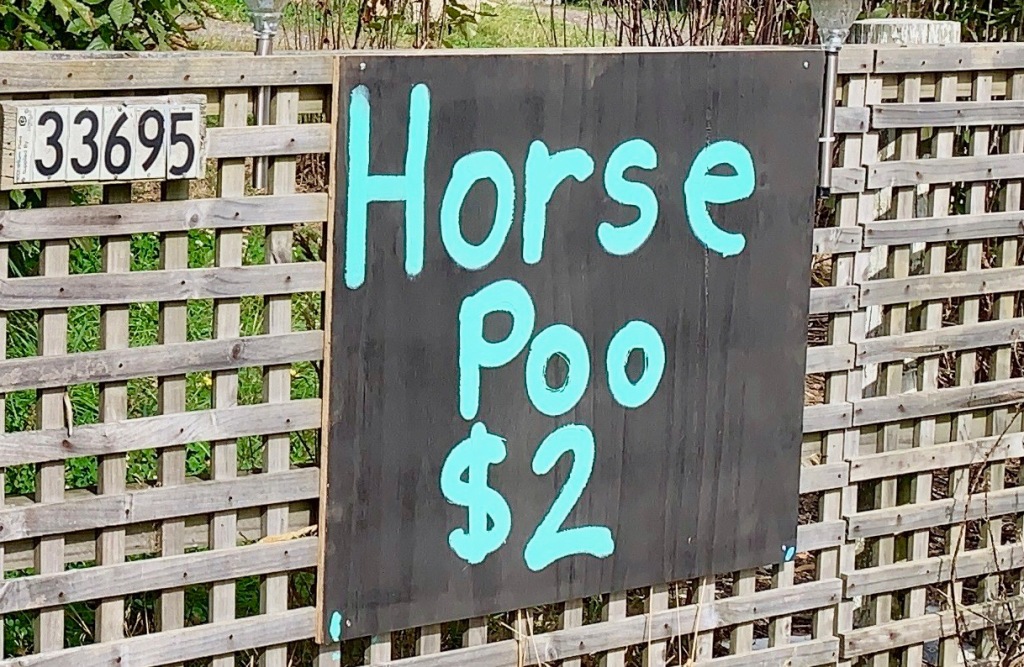
we held our noses as we drove past, but the price got our attention. in hobart, by contrast, where poo seems to be a preoccupation, they slap a clever label on it and jack up the price for tourists. we suspect that stuff might be the cheaper “bull” variety corporate media are peddling.
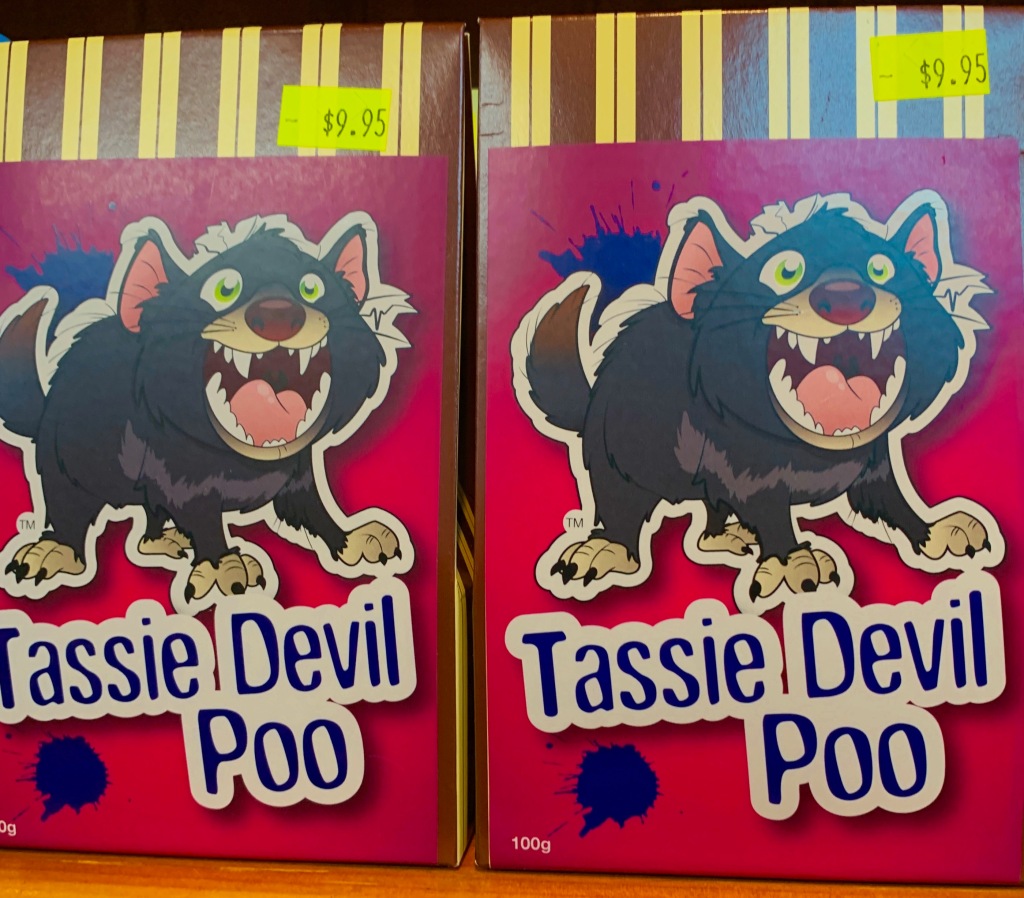
after that assault on our olfactory senses, we set our compass toward hobart, tassie’s capital, largest city (pop. 200,000) and, little did we know, a burgeoning global center of the arts.
our plan was to take a dirt road shortcut through the mountains to sneak a peek at a waterfall recommended by friends.
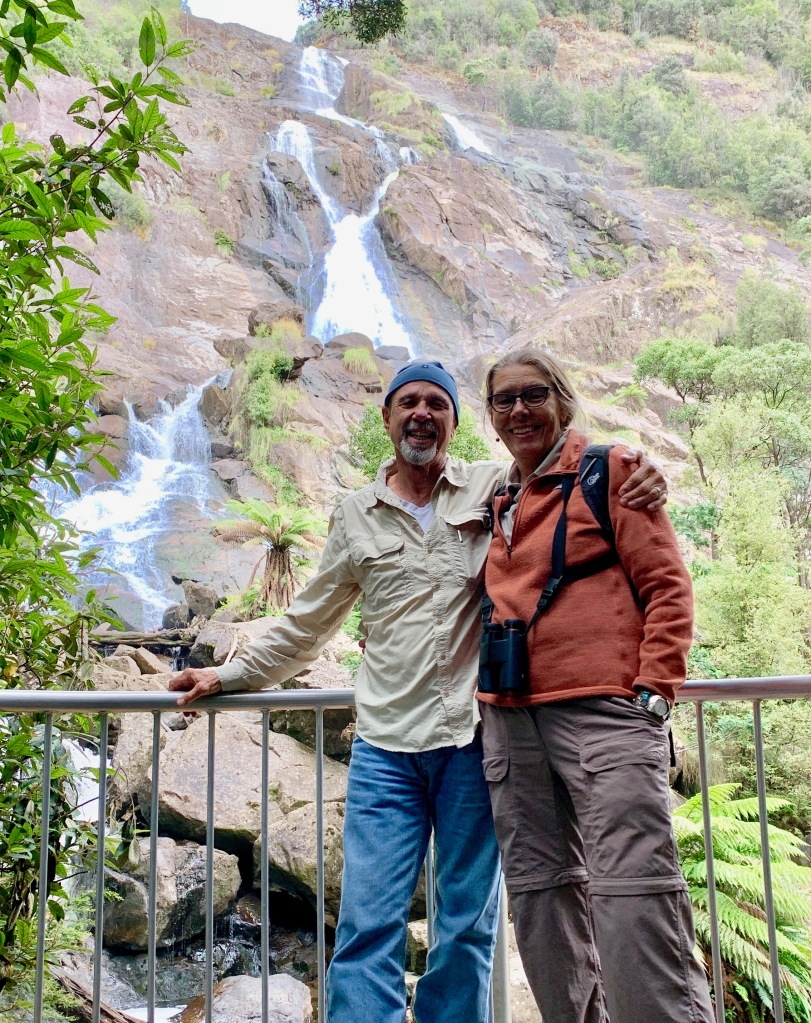
the waterfall didn’t disappoint, but a sign at the parking lot did. “road closed ahead,” it said. bridge repair. the only option was retracing our tracks back to the bitumen highway.
we shared our anguish with a forlorn-looking couple standing with us as we contemplated our options. they had driven down from tassie’s north coast to lunch at an artesinal farm just past where the bridge was out. the road closure meant adding more than 100 kilometers to their journey. they were out.
we, on the other hand, had to go that way to get to hobart anyway, and the mouth watering prospect of cheddar straight from the udder was irresistible to a couple cheese-aholics. the detour was a minor inconvenience. we were in. they told us the name to look for: pyengana. (pop. 123)
our GPS was a little unsure about pyengana’s location, and for good reason. when we got to the place marked “pyengana” on the screen, there was nothing but fields as far as the eye could see. not a building. not a sign, not an intersection. just as our tummies were cursing the people who’d told us about pyengana, we discovered a dirt track through the fields. as we turned we saw a board among the bushes with a single word: “dairy”. sure enough, up the path a bit, (a hilariously imprecise term in oz), paydirt.

we went in, bellied up to the cheese bar, ordered what we later learned was three sampler plates (oops, we had to eat them), then wandered out to the back lawn to find a table. there we found a troupe of trained cows in the midst of a matinee performance for an assortment of young children, accompanied by their cheese-freak parents. it was modern milking, 101.

each of pyengana farm’s 220 cows wears a computer-coded ID necklace that communicates with a state-of-the-art robotic milking system. so when bessie mae (not her real name) feels the urge, she ambles over to the pen. if it’s been at least six hours since she’s been milked, the gate unlocks and she nudges it open.
once inside, she gets a treat, then sidles up to a milking machine, where suction cups attach to her teats. (the kids can’t actually see that part) afterward, bessie mae can stop at a back scratching device before returning to the paddock to fill up for her next visit. bessie and her pals each happily produce about 10 gallons (38 kilometers) of milk a day.

ve gates 
education 
history 
mom, are all cows girls? 
bessie mae moocho
eventually it occurred to us that we hadn’t come to tassie to eat cheese and watch cows being milked, so we resumed our quest for hobart, which not coincidentally is the birthplace of denmark’s crown princess mary. it’s also a bustling seaport with a thriving shipbuilding industry and a rich, though checkered, heritage.
the route south to hobart was littered with tourist attractions and fine dining opportunities. imagine the culinary delights at “the pavement”. (tables optional)
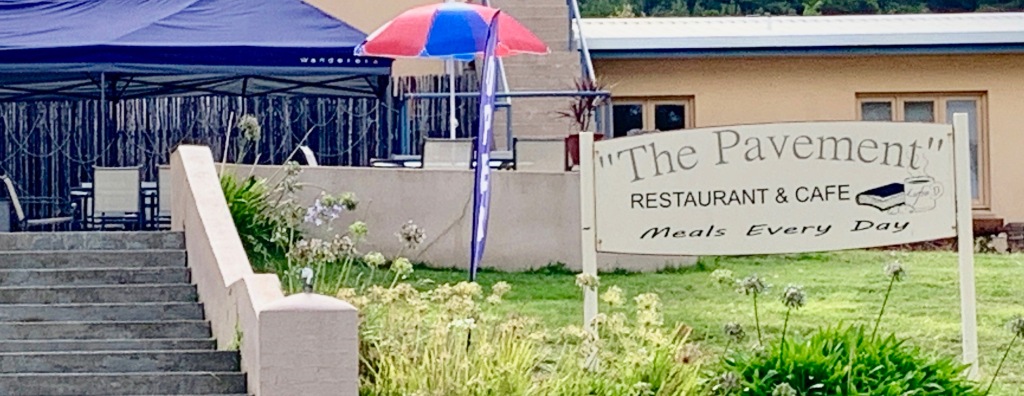
i was tempted to check the drinks menu to see if if might feature a “concrete mixer” on the rocks. the imagination boggles at the possibilities. but we only had time for photos.

the pavement restaurant, by the way, is just across the asphalt from an actual park dedicated to ‘tessellated pavement’, a fascinating but not too photogenic natural phenomenon occurring along the coastline.

it’s naturally paved 
a field for playing “step on a crack…” 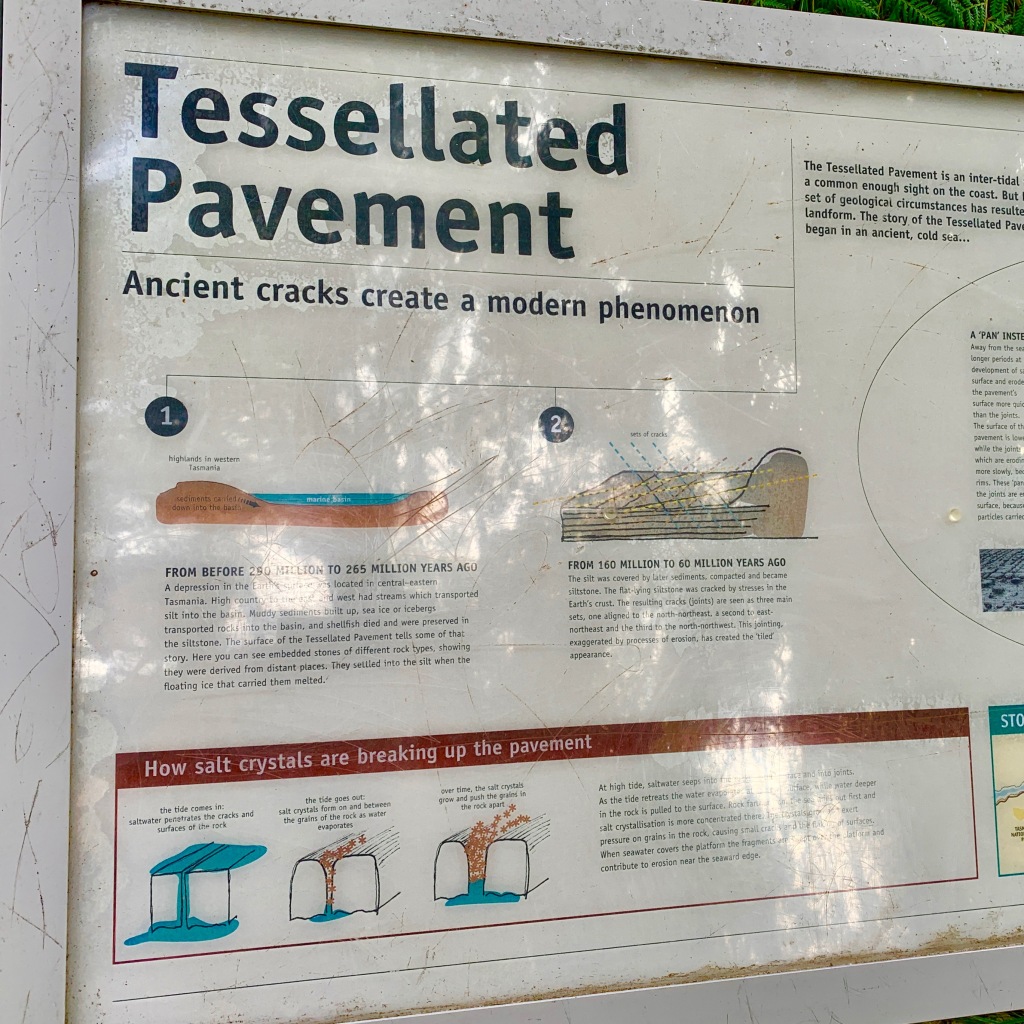
so what’s the deal? pavement vs. asphalt vs. bitumen. enquiring minds don’t care, so is this worth your valuable time? i’ve always called a paved road ‘asphalt’. aussies seem to prefer the term ‘bitumen’. technically, according to asphalt.com, bitumen is the black gooey stuff that holds the asphalt (the pebbly stuff) together. it’s also called pitch. (as in, that’s strike three on your attempt at aussie humor, mate)
“black as bitumen” is also an apt descripion of tassie’s history. the dutch explorer abel tasman was the first european to set foot there in 1642. he named it van dieman’s land to honor his boss, who had commissioned the voyage.
but then the demons took hold. soon after the british arrived, around 1803, they waged a 25-year “black war” that nearly exterminated the aboriginal people who had been there for tens of thousands of years. and partly to substantiate england’s claim to van dieman’s land, they turned it into a dumping ground for convicts, establishing penal colonies that besmirched the island’s reputation for the next half century.
when they realized this wasn’t working out so well, convict transportation was ended in 1856, and as part of an image makeover, the island’s name was changed to tasmania (after abel tasman)
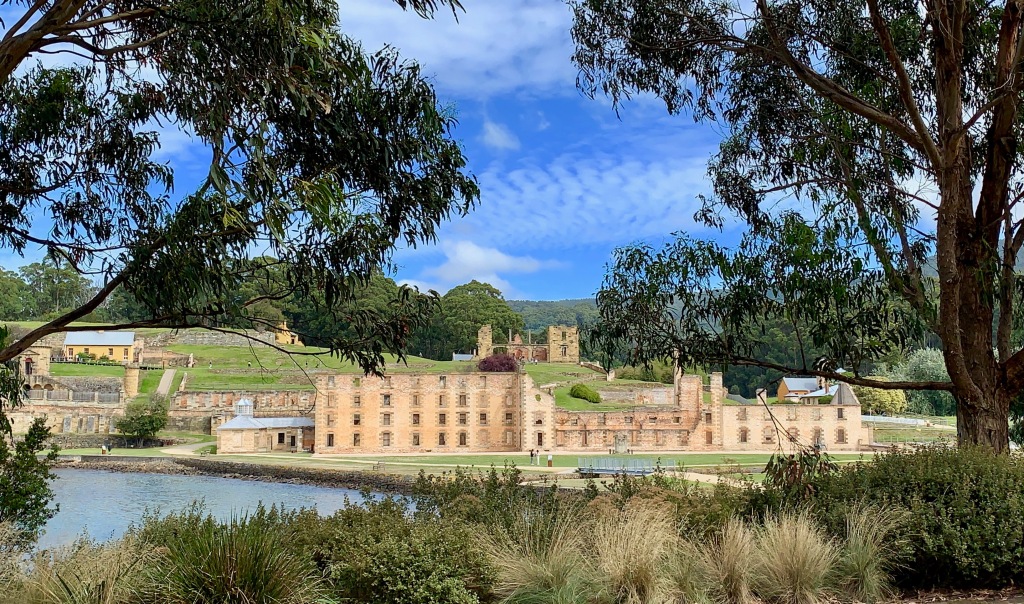
to learn a bit of the history, we drove 90 km south of hobart to port arthur, australia’s best preserved convict settlement, where repeat offenders and so-called “incorrigibles” were sent. it’s a hauntingly beautiful campus.

convict james rogers 
bars encased in meter thick walls 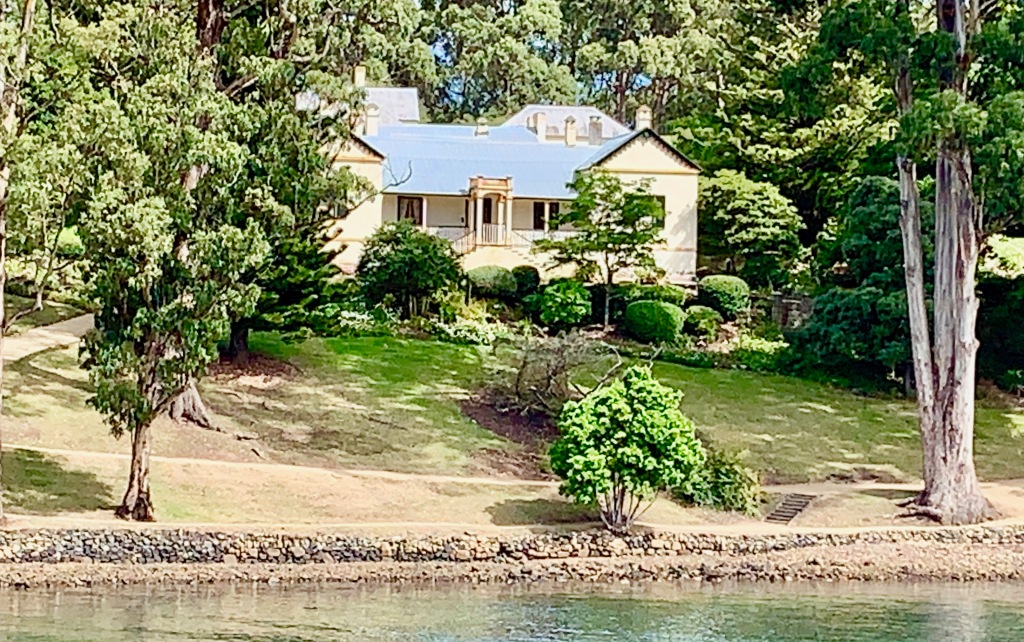
the commandant’s house 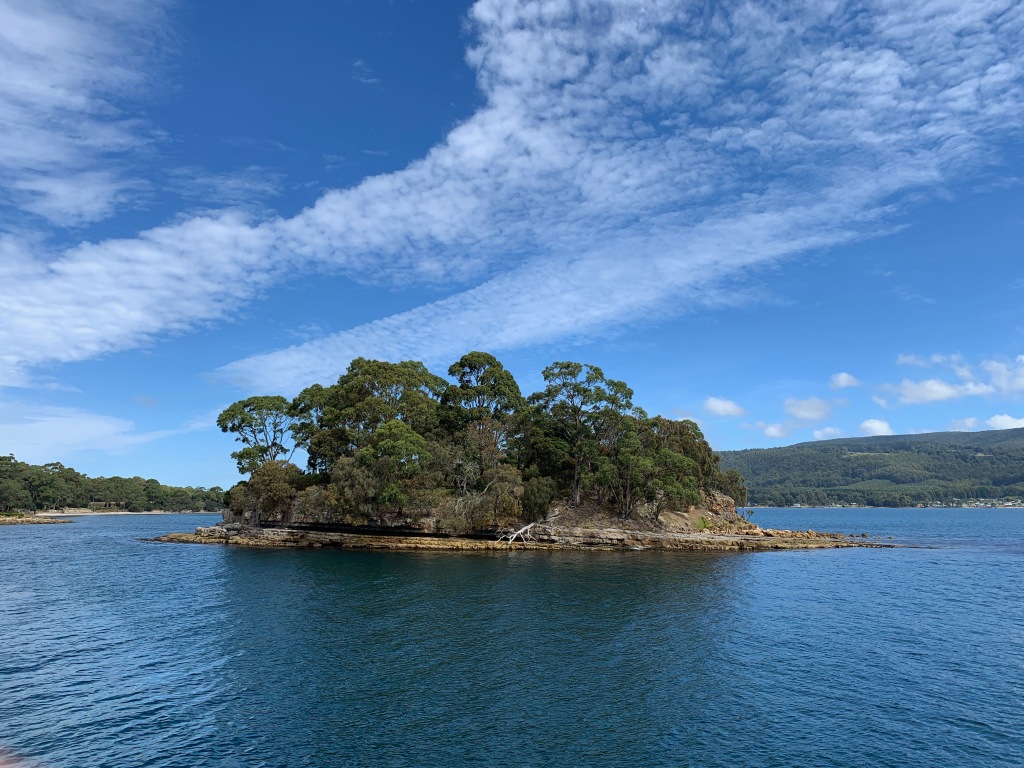
“incorrigibles” were isolated on islands 
the main dormitory housed 200 inmates on four levels
interestingly, port arthur employed a photographer to take pictures of inmates. those pictures are being used to memorialize many of the convicts, such as james rogers, (above) who was sentenced in birmingham, england to seven years in 1849 at the age of 24 for “stealing monies”.
rogers was transported to tassie in a convict ship, did his time, and was freed in 1856, just as port arthur was being transformed from a penal colony to an institution for aged and ill convicts. he remained in hobart, where he ran afoul of the law again twelve years later for altering a one pound note and passing it off as a fiver to pay for a pint of beer for himself and a mate.
his trial received daily front page coverage in the hobart newspaper, and word-for-word transcriptions of the court testimony are available online. they make fascinating reading. the stories of other convicts are being posted each month as research is completed.
after serving his second sentence, rogers was released in 1874 and lived out the rest of his life in hobart. he died a pauper at a charitable home in 1899, at the age of 74.
with its blighted past and remote location, hobart muddled along, a backwater on the southern edge of the populated world, for more than 150 years after the penal colonies closed.
until….in 2011…
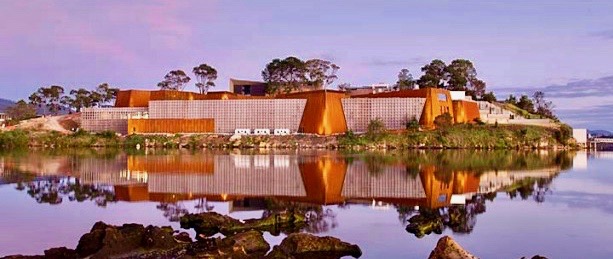
the art in hobart exploded. (leaving only an artless hob) that’s when mona, the “museum of old and new art” opened, bankrolled with the gambling fortune of native son and art collector david walsh.
the mona experience begins at the docks in hobart, from where a high-speed catamaran whisks patrons 25 minutes up the derwent river and deposits them at the base of a 99 step staircase to the museum’s entrance.
we had a minor misunderstanding at the ticket window, however. we intended to save a few bucks, and thought we’d purchased the “cheap seats”.
there was a cow there, too, apparently to demarcate “cattle class”. we’ll know better next time. on the other hand, it was a better deal than the horse poo.


mona was intended as a sort of subversive anti-museum labyrinth. walsh blasted a huge hole in a sandstone peninsula overlooking the derwent river not far from the hardscrabble neighborhood where he grew up. he filled it with three subterranean levels of objets d’art, many of which he had acquired as he traveled the globe popping in at unsuspecting casinos and cleaning them out by counting cards at the blackjack tables (until he was banned). his goal was to put everyday emotions at the center of his gallery, so what better to focus on than procreation, expiration, and oh yes, defecation? (mostly sex and death)
it’s probably not surprising then that mona’s most hated, and most popular display is, can you guess? of course. what else — a poo machine.
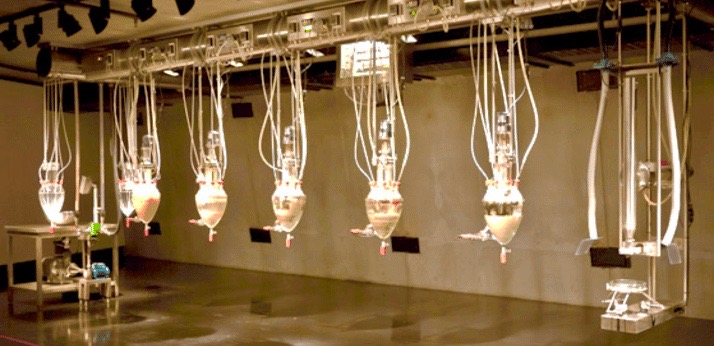
we missed the daily dump, but people apparently time their visits to be there to see the ingestion, digestion, and particularly the excretion process, complete with the attendant sound and fury (and smell). it’s so… so low-brow.

a ‘white library’ of empty books. no content 
a head-scratching optical illusion 
a sunscreen dispenser with a foot pedal
(it’s real)
walkway illuminated 
apocalyptic art
almost overnight, mona transformed hobart into a global art capital. international critics flocked to tassie to experience walsh’s concept of art for everyone. some raved. one called it a “watershed in the way art is understood”. others ridiculed it as the end of art, or even worse in walsh’s eyes, conventional. but aussies adored it.
in the ten years since it opened , the museum has logged a quarter of a million visits in a city of fewer than 200,000. tassies get in free, of course. all others pay.
in that decade, tassie’s tourism revenue has jumped 50%. in 2013, lonely planet listed hobart among it’s go-to destinations. celebrated chefs are relocating there, and high-end hotels are springing up to meet the tastes of museum tourists.
walsh is considering his own hotel that will include his unique take on the concept of a library. he has said the shelves will be stocked largely with his own books, including a “large and growing nerd fest of bibliophilic paraphernalia courtesy of total lightweights like einstein, newton, darwin and dickens”. he also has over 300 works of isaac asimov (he’s read them all), and i suspect, a few by that other heinlein.
walsh has told interviewers one secret of his success is that he owns the gallery outright. it’s his own private collection, so he can display whatever he damn well pleases. there’s no board or governing body to overrule his decisions; no public funding. he’s single-handedly proven a small city on the edge of civilization can rewrite the rules of a game previously controlled by the art establishment in major world capitals. so who’s to tell him how to do it?
and on top of it all, standing on the rock just outside the entrance, he’s installed another wim delvoye classic; a concrete mixer fabricated from intricately patterned laser-cut steel.
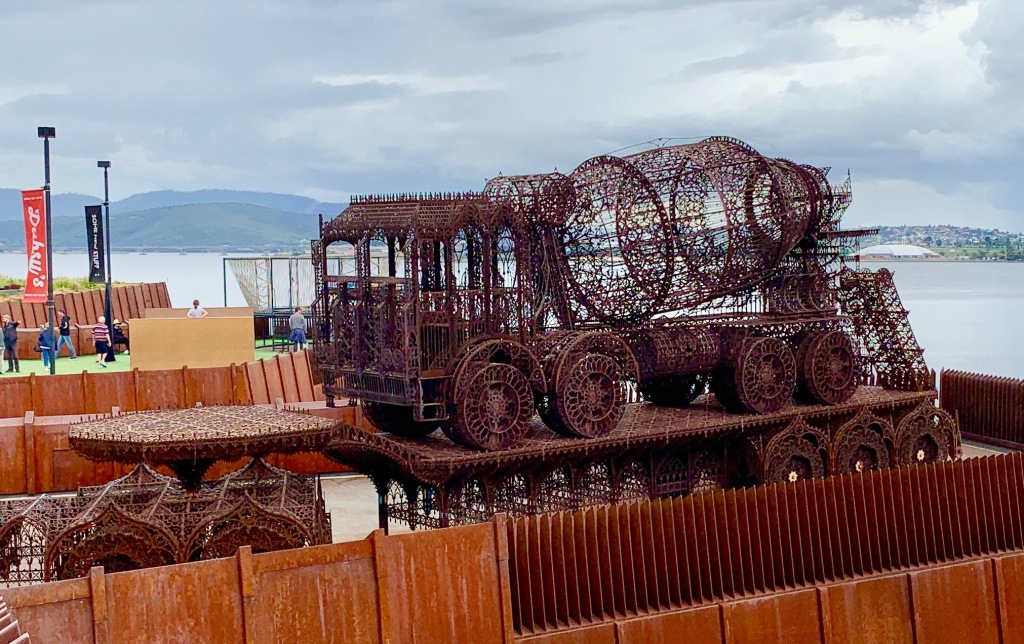
so there it is, folks. a concrete mixer on the rocks. i think i’ll have a double.
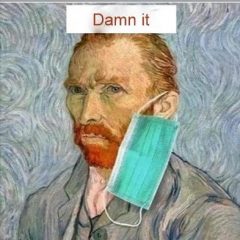


Dear Peter, Yes, you are right , it is long. It is interesting . I likes the part about Bessie Mae. I did stay up to read it so maybe I am tired and terfore a bit more critical . I am off to bed. Looking forward to tomorrow. I love you MOM
LikeLike
Terrific, funny, entertaining, good stuff cousin, bravo. ….Greg
LikeLike
thanks, greg. your kind words are encouraging. btw, my daughter is moving to california today. she’s driving through arizona as i write. she’s going to park her car in el centro and walk the pacific crest trail for the next 5 months before starting grad school at u-c-davis in the fall.
LikeLike
Enjoyed your tassie blog Peter! Thanks for sharing. How is the beer in Tasmania?
LikeLike
honestly, rick, the tassie beer is so-so. we were, however, able to get our favorite mainland beer, which is brewed in geelong, (a suburb of melbourne), which is turns out is, after hobart, one of the five southernmost cities in the world. it’s a dark ale called white rabbit, which i drink in my quidi vidi brewery glass when home. it’s gorgeous. we are hoping you’ve got oz on your travel bucket list.
LikeLike
i recommend you book a flight here as soon as the gates open and your hip is ready. the beer is worth tasting.
LikeLike